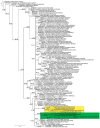Morphometric and Molecular Analyses of Ostertagia leptospicularis Assadov, 1953 from Ruminants: Species Diversity or Host Influence?
- PMID: 33466738
- PMCID: PMC7829921
- DOI: 10.3390/ani11010182
Morphometric and Molecular Analyses of Ostertagia leptospicularis Assadov, 1953 from Ruminants: Species Diversity or Host Influence?
Abstract
Ostertagia leptospicularis Assadov, 1953 was formally described in roe deer Capreolus capreolus and has been reported in a wide range of ruminants, including other Cervidae, as well as Bovidae. Nematode specimens derived from various host species exhibit morphological similarity; however, some differences can be observed. It is unclear if this is due to the differential reaction of one nematode species in different host species (i.e., host-induced changes) or because of distinct nematode species in these hosts (i.e., species complex). This paper focuses on specimens resembling O. leptospicularis f. leptospicularis and its closely related species (Ostertagia ostertagi f. ostertagi) collected from various hosts. Morphometric and molecular techniques were applied to assess host-induced changes in nematode morphology and to clarify its systematic classification. There was an overall effect of host species on measurements of nematodes resembling O. leptospicularis (both males and females), but the distinctiveness of the specimens from cattle Bos taurus were highlighted. The results obtained may suggest that the specimens of O. leptospicularis from cattle in Germany and cervids in central Europe belong to different strains. Furthermore, nematodes from the cervid strain appear to circulate within particular host species, which can be seen in the stated morphological variations.
Keywords: Bovidae; Cervidae; ITS-2; Ostertagia leptospicularis; morphology; morphometrics; strains.
Conflict of interest statement
The authors declare no conflict of interest.
Figures






References
-
- Assadov S.M. On the study of the fauna of the Trichostrongylidae of the roe in Azerbaidjan. Izv. Akad. Nauk Azerbaidjan SSR. 1953;1:59–66. (In Rusian)
LinkOut - more resources
Full Text Sources
Other Literature Sources

